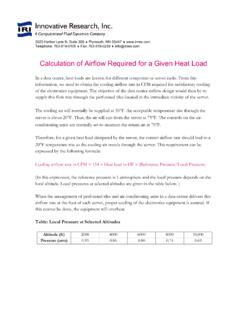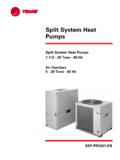Transcription of Understanding Thermal Dissipation and Design of a Heatsink
1 -JAJADTT =P-JMAXADMAXJATTP= ApplicationReportSLVA462 printed-circuitboard(PCB) running,it consumeselectricalenergythatis typicallygeneratedbyswitchingdeviceslike MOSFETs,ICs, properheatsinkfora (TJMAX) is oneofthekeyfactorsthatlimitthepowerdissi pationcapabilityofa definedbythemanufacturerandusuallydepend sonthereliabilityofthedieusedin shownin Equation2:(1)Where: JA= thermalresistanceTJ= junctiontemperatureTA= ambienttemperaturePD= powerdissipationTodiscoverthemaximumpowe rthatthedevicecandissipate,rearrangeEqua tion2 to:(2)Withthehelpof JAandTJMAX, whicharementionedin theTPS54325datasheet(SLVS932), ,in thedatasheet, JAis C/WandTJMAXis givenas125 C and85 C,onecanarriveatthevaluesmentionedin , linear,soif thedissipationis 2250mWfora 100 C rise(from25 C to125 C)
2 ,foreachonedegreeincreasein ambienttemperature,thepowerdissipationra tinghastobedecreased2250/100= sometimesusedforcalculation, specificsynchronousbuckconverterapplicat ionwheretheinputis 5 V andoutputis at1 A, notthepowerdissipatedin a datasheetfortheapplication,anassumptiono ftheefficiencyis tobeconsidered(90%) ,theinputpowerin thiscaseis ,andthepowerdissipationin theconverteris dissipatedin theinductor,whichis ,theinductorpoweris:Pinductor= Iout2 DCR= 12 100 10-3= now250mW- 100mW= 150mW,andthejunctiontemperatureriseabove ambientis calculatedusingtheformula.
3 1 SLVA462 May2011 UnderstandingThermalDissipationandDesign ofa HeatsinkSubmitDocumentationFeedbackCopyr ight 2011,TexasInstrumentsIncorporated-JAJCCS SAJAJCCSSAD = + + TT= + + P---JASAJCCSDTT = ( JA PD) + TA= TJTJ= 75 + TA= C aboveambient(75 C/Wis thethermalresistancetakenasa example)Consideranotherexampleofcalculat ingthedissipationofa , theunloadedpowerdissipationinherenttothe deviceandtheloadpowerdissipation,whichis a (total)= PD(unloaded)+ PD(loaded)Powerdissipationin anunloadedlogicdevicecanbecalculatedusin gthefollowingequations:PD(unloaded)= VCC ICIC= ICC+ Iinput+ IdynamicWhere:VCC= supplyvoltageICC= quiescentcurrentIinput= totalcurrentwheninputsarehighIdynamic= powersupplycurrentperunitfrequencyIinput = II NI DIandIdynamic= Cpd VccWhere:II= supplycurrentfora highinputNI= numberofinputsonhighlevelDI= dutycycleofinputsathighlevelCpd= powerdissipationcapacitanceTheloadingofa , a loadedlogicdevicecanbecalculatedusingthe followingequations:PD(loaded)= VOH NO f CLWhere.
4 VOH= logichighoutputvoltageNO= numberofoutputsloadedwithCLf = outputswitchingfrequencyCL= loadcapacitanceperoutputHeatsinkDesign JAis actuallymadeupofatleasttwoseparatetherma lresistancesin thethermalresistanceinsidethedevicepacka ge,betweenthejunctionanditsoutsidecase,c alled JC. Theotheristheresistancebetweenthecaseand theambient, CA. Because JCis underthecontrolofthemanufacturer,nothing canbedonewithit. It is wheretheheatsinkin CAis nowsplitinto CSand SA, where Sis thethermalresistanceoftheinterfacecompou ndused,and SAis now:(3)Rearrangingthis:(4)2 UnderstandingThermalDissipationandDesign ofa HeatsinkSLVA462 May2011 SubmitDocumentationFeedbackCopyright 2011, ,theTJ, PD, and JCaregivenin thedevicemanufacturer'sdatasheet.
5 Whichthecomponentis ,it rangesfrom35 C to45 C,if theexternalairflowthrougha fanis usedandfrom50 C to60 C,if thecomponentis CSdependsmainlyontheinterfacematerialand itsthicknessandalsoonthesurfacefinish,fl atness,appliedmountingpressure, , SAbecomestherequiredmaximumthermalresist anceofa ,thethermalresistancevalueofa chosenheatsinkfortheapplicationhastobeeq ualtoorlessthantheprevious selectinga typicallymeasuredin linearfeetperminute(LFM)orCFM(cubicfeetp erminute).LFMis ameasureofvelocity,whereasCFMis a ,fanmanufacturersuseCFMbecausefansarerat edaccordingtothequantityofairit (speed)is moremeaningfulforheatremovalattheboardle vel,whichis ,airflowis a veryimportantin naturalconvection,asit canberesponsibleforapproximately25% facinga hottersurfacenearby,it is inducedbymechanicalmeans,usuallya heatsinkfora givenflowconditioncanbeobtainedbyusingth efollowingequation:Volume( Heatsink )= volumetricresistance(Cm3 C/W)/thermalresistance SA( C/W)Anapproximaterangeofvolumetricresist anceis givenin thefollowingtable.
6 AvailableAirflowVolumetricResistance(LFM )(Cm3 C/W)NC500 800200150- 25050080- 150100050- 80 Thenextimportantcriterionfortheperforman ceofa heatsinkis is linearlyproportionaltotheperformanceofth eheatsinkin ,anincreasein thewidthofa heatsinkbya factoroftwo,three,orfourincreasetheheatd issipationcapabilitybya factoroftwo,three, ,thesquarerootofthefinlengthusedis approximatelyproportionaltotheperformanc eoftheheatsinkin thelengthoftheheatsinkbya factoroftwo,three,orfouronlyincreasesthe heatdissipationcapabilitybya , , theboardhassufficientspace,it is alwaysbeneficialtoincreasethewidthofa onlythebeginningofaniterativeprocessbefo rethecorrectandtheactualheatsinkdesignis May2011 UnderstandingThermalDissipationandDesign ofa HeatsinkSubmitDocumentationFeedbackCopyr ight 2011,TexasInstrumentsIncorporatedIMPORTA NTNOTICET exasInstrumentsIncorporatedanditssubsidi aries(TI)
7 Reservetherighttomakecorrections,modific ations,enhancements,improvements, s accordancewithTI s ,testingofallparametersofeachproductis , ,eitherexpressorimplied,is grantedunderanyTIpatentright,copyright,m askworkright,orotherTIintellectualproper tyrightrelatingtoanycombination,machine, orprocessin licensefroma thirdpartyunderthepatentsorotherintellec tualpropertyofthethirdparty,ora TIdatabooksordatasheetsis permissibleonlyif reproductionis withoutalterationandis accompaniedbyallassociatedwarranties,con ditions,limitations, safety-criticalapplications(suchaslifesu pport)wherea failureoftheTIproductwouldreasonablybeex pectedtocauseseverepersonalinjuryordeath , thesafetyandregulatoryramificationsofthe irapplications,andacknowledgeandagreetha ttheyaresolelyresponsibleforalllegal,reg ulatoryandsafety-relatedrequirementsconc erningtheirproductsandanyuseofTIproducts in suchsafety-criticalapplications, , military/aerospaceapplicationsorenvironm entsunlesstheTIproductsarespecificallyde signatedbyTIasmilitary-gradeor"enhancedp lastic.
8 " solelyattheBuyer's risk,andthattheyaresolelyresponsibleforc ompliancewithalllegalandregulatoryrequir ementsin ,if theyuseanynon-designatedproductsin automotiveapplications, , :TexasInstruments,PostOfficeBox655303,Da llas,Texas75265 Copyright 2011,TexasInstrumentsIncorporat














